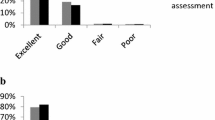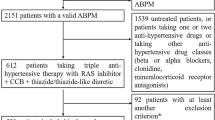Abstract
Background and Objectives: Although strict blood pressure (BP) control is effective in the prevention of cardiovascular events, it is often insufficient in many hypertensive patients. B-type natriuretic peptide (BNP) has been shown to be associated with cardiovascular events. We investigated the effects of the losartan/hydrochlorothiazide combination on BP and plasma BNP in hypertensive patients uncontrolled by an angiotensin II type 1 receptor antagonist (angiotensin receptor blocker [ARB])-based therapy.
Methods: In a multicentre prospective observational study, we enrolled 185 patients aged 36–79 years (mean age 63.8 years) with essential hypertension but without symptoms of heart failure who received an ARB-based therapy for ≥3 months but failed to achieve a target BP recommended by the Japanese Society of Hypertension (JSH). ARBs were switched to losartan (LOS) 50 mg/hydrochlorothiazide (HCTZ) 12.5 mg. The anti-hypertensive efficacy, safety, and effects of this combination on blood biochemical parameters and plasma BNP were evaluated for 12 months.
Results: Mean ± SD systolic and diastolic BP decreased from 152 ± 13/87 ± 10 mmHg to 128 ± 14/74 ± 10 mmHg, respectively, after 12 months (p < 0.001). Mean ± SD plasma BNP levels decreased significantly from 46.0 ± 83.0 pg/mL to 40.8 ± 68.0 pg/mL (p < 0.05). The percentage of patients who achieved the JSH 2004 target BP was 51% after 12 months; the percentage was 63% in elderly patients aged ≥65 years without complications, and 43% in patients with concomitant diabetes mellitus or chronic kidney disease. No association was found between a decrease in plasma BNP levels and BP, age, body mass index or estimated glomerular filtration rate. There was a significant increase in serum uric acid and a decrease in serum potassium, but both were within the range of normal values. Adverse events were observed in 8.6% of the patients.
Conclusion: Antihypertensive treatment using two types of drugs (LOS/HCTZ) with different mechanisms yielded potent antihypertensive efficacy with safety and decreased plasma BNP levels.






Similar content being viewed by others
References
Collins R, Peto R, MacMahon S, et al. Blood pressure, stroke, and coronary heart disease: part 2. Short-term reductions in blood pressure: overview of randomised drug trials in their epidemiological context. Lancet 1990; 335: 827–38
Staessen JA, Wang JG, Thijs L. Cardiovascular protection and blood pressure reduction: a meta-analysis. Lancet 2001; 358: 1305–15
Japanese Society of Hypertension. Japanese Society of Hypertension guidelines for the management of hypertension (JSH 2004). Hypertens Res 2006; 29 Suppl.: S1–105
The sixth report of the Joint National Committee on Prevention, Detection, Evaluation, and Treatment of High Blood Pressure. Arch Intern Med 1997; 157: 2413-46
Hozawa A, Ohkubo T, Kikuya M, et al. Blood pressure control assessed by home, ambulatory and conventional blood pressure measurements in the Japanese general population: the Ohasama Study. Hypertens Res 2002; 25: 57–63
Heart Care Network Groups. Current trends in lifestyle-related disease management by general practitioners: a report from the ‘Heart Care Network’ groups. J Atheroscler Thromb 2009; 16: 799–806
Mahmud A, Feely J. Low-dose quadruple antihypertensive combination: more efficacious than individual agents — a preliminary report. Hypertension 2007; 49: 272–5
Ogihara T, Kikuchi K, Matsuoka H, et al., Japanese Society of Hypertension Committee. The Japanese Society of Hypertension guidelines for the management of hypertension (JSH 2009). Hypertens Res 2009; 32: 3–107
Hirata Y, Matsumoto A, Aoyagi T, et al. Measurement of plasma brain natriuretic peptide level as a guide for cardiac overload. Cardiovasc Res 2001; 51: 585–91
Tsuchida K, Tanabe K. Plasma brain natriuretic peptide concentrations and the risk of cardiovascular events and death in general practice. J Cardiol 2008; 52: 212–23
Wang TJ, Larson MG, Levy D, et al. Plasma natriuretic peptide levels and the risk of cardiovascular events and death. N Engl J Med 2004; 350: 655–63
Suzuki M, Hamada M, Yamamoto K, et al. Brain natriuretic peptide as a risk marker for incident hypertensive cardiovascular events. Hypertens Res 2002; 25: 669–76
Olsen MH, Wachtell K, Tuxen C, et al. N-terminal probrain natriuretic peptide predicts cardiovascular events in patients with hypertension and left ventricular hypertrophy: a LIFE study. J Hypertens 2004; 22: 1597–604
Olsen MH, Wachtell K, Tuxen C, et al. Opposite effects of losartan and atenolol on natriuretic peptides in patients with hypertension and left ventricular hypertrophy: a LIFE substudy. J Hypertens 2005; 23: 1083–90
Murai K, Obara T, Ohkubo T, et al., J-Home Study Group. Current usage of diuretics among hypertensive patients in Japan: the Japan Home versus Office Blood Pressure Measurement Evaluation (J-HOME) study. Hypertens Res 2006; 29: 857–63
Hirose H, Kawabe H, Saito I. Effects of losartan/ hydrochlorothiazide treatment, after change from ARB at usual dosage, on blood pressure and various metabolic parameters including high-molecular-weight adiponectin in Japanese male hypertensive subjects. Clin Exp Hypertens 2011; 33: 41–6
Kjeldsen SE, Schmieder RE, Unger T, et al. Telmisartan and hydrochlorothiazide combination therapy for the treatment of hypertension. Curr Med Res Opin 2010; 26: 879–87
Kim KS, Fan WH, Kim YD, et al., Asia HEAALTH Study Investigators. Effectiveness of open-label losartan/hydrochlorothiazide combination therapy in Asian patients with hypertension not controlled with ACE inhibitor or ARB monotherapy. Hypertens Res 2009; 32: 520–6
Kinouchi K, Ichihara A, Sakoda M, et al. Safety and benefits of a tablet combining losartan and hydrochlorothiazide in Japanese diabetic patients with hypertension. Hypertens Res 2009; 32: 1143–7
Shimosawa T, Gohchi K, Yatomi Y, et al. Effectiveness of add-on low-dose diuretics in combination therapy for hypertension: losartan/hydrochlorothiazide vs. candesartan/ amlodipine. Hypertens Res 2007; 30: 831–7
Kita T, Yokota N, Ichiki Y, et al. One-year effectiveness and safety of open-label losartan/hydrochlorothiazide combination therapy in Japanese patients with hypertension uncontrolled with ARBs or ACE inhibitors. Hypertens Res 2010; 33: 320–5
Mancia G, Laurent S, Agabiti-Rosei E, et al. European Society of Hypertension. Reappraisal of European guidelines on hypertension management: a European Society of Hypertension Task Force document. J Hypertens 2009; 27: 2121–58
Soualmia H, Ayadi I, Omar S, et al. Atrial natriuretic peptide and brain natriuretic peptide release in human essential hypertension. Clin Lab 2009; 55: 120–7
Kohno M, Horio T, Yokokawa K, et al. Brain natriuretic peptide as a cardiac hormone in essential hypertension. Am J Med 1992; 92: 29–34
Uusimaa P, Tokola H, Ylitalo A, et al. Plasma B-type natriuretic peptide reflects left ventricular hypertrophy and diastolic function in hypertension. Int J Cardiol 2004; 97: 251–6
Paget V, Legedz L, Gaudebout N, et al. N-terminal probrain natriuretic peptide: a powerful predictor of mortality in hypertension. Hypertension 2011; 57: 702–9
Dahlof B, Zanchetti A, Diez J, et al. Effects of losartan and atenolol on left ventricular mass and neurohormonal profile in patients with essential hypertension and left ventricular hypertrophy. J Hypertens 2002; 20: 1855–64
Seki S, Tsurusaki T, Kasai T, et al. Clinical significance of B-type natriuretic peptide in the assessment of untreated hypertension. Circ J 2008; 72: 770–7
Kawai T, Takei I, Shimada A, et al. Effects of olmesartan medoxomil, an angiotensin II type 1 receptor antagonist, on plasma concentration of B-type natriuretic peptide, in hypertensive patients with type 2 diabetes mellitus: a preliminary, observational, open-label study. Clin Drug Investig 2011; 31: 237–45
Shiga Y, Miura SI, Mitsutake R, et al. Effect of fixed-dose losartan/hydrochlorothiazide on brain natriuretic peptide in patients with hypertension. J Renin Angiotensin Aldosterone Syst. Epub ahead of print. doi:10.1177/1470320311415135
Clerico A, Emdin M. Diagnostic accuracy and prognostic relevance of the measurement of cardiac natriuretic peptides: a review. Clin Chem 2004; 50: 33–50
Acknowledgements
This study was supported by a research grant from the clinical research support project by the Japan Heart Foundation. The authors alone are responsible for the content and writing of the paper. The authors have no conflicts of interest that are directly relevant to the content of this study.
Southern Heart Conference Study Group members (in alphabetical order): Noriyasu Fujino, Yutaka Fukuizumi, Takashi Inoue, Hiroyuki Kohno, Katsuhiko Kubara, Hidehiko Morinaga, Norihiko Morinaga, Eiichi Murayama, Shunichi Nagahama, Kensuke Nomiyama, Keiji Oi, Katsunori Osada, Yoji Sagara, Shigeki Sako, Manabu Sasaguri, Hideaki Shigematsu, Ichiro Shimada, Ryuji Shimamura, Masanori Shimizu, Nobuhiro Suematsu, Tomomasa Suematsu, Kazuyuki Takata, Eiji Tatewaki, Masahisa Terasawa, Yasuhiro Umeki, Sakon Yatabe, and Misao Yamasaki.
Author information
Authors and Affiliations
Corresponding author
Rights and permissions
About this article
Cite this article
Meno, H., Inou, T., Tanaka, M. et al. Antihypertensive Efficacy of the Losartan/Hydrochlorothiazide Combination and its Effect on Plasma B- Type Natriuretic Peptide in Hypertensive Patients Uncontrolled by Angiotensin II Type 1 Receptor Antagonist-Based Therapy. Clin Drug Investig 32, 171–178 (2012). https://doi.org/10.2165/11597620-000000000-00000
Published:
Issue Date:
DOI: https://doi.org/10.2165/11597620-000000000-00000




